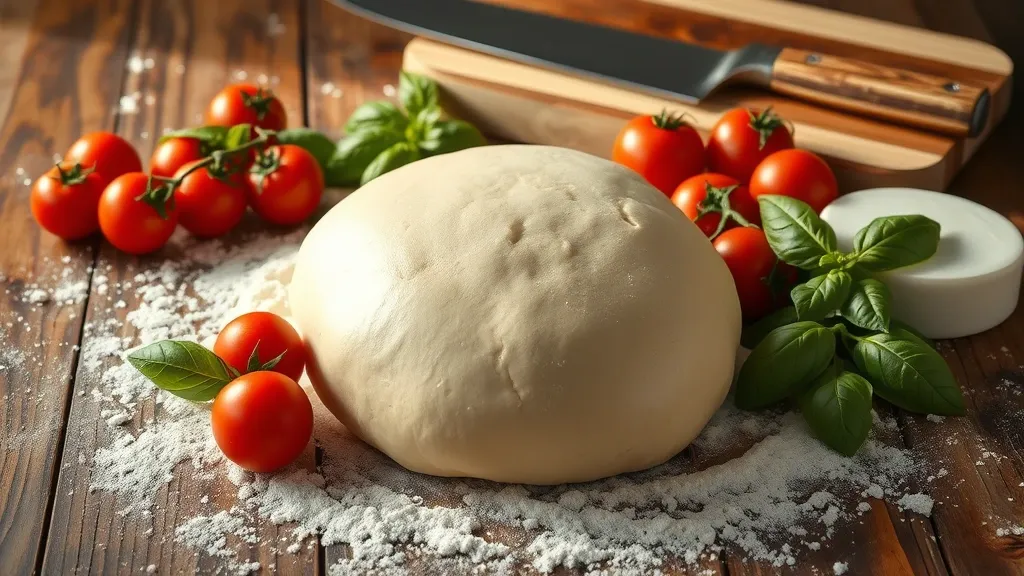The Alchemy of Ingredients: Why Flour Matters More Than You Think
You might think that pizza dough is just a simple blend of flour, water, yeast, and salt, but let me tell you, the type of flour you choose can totally change the game. Seriously, it’s like the secret superhero of your pizza. So, let’s dive into why flour matters more than you might think!
First off, not all flour is created equal. You’ve got your all-purpose flour, bread flour, and then there’s that fancy “00” flour that everyone raves about. Each type has a different protein content, and this is super important because it affects the dough’s strength and texture. High-protein flours, like bread flour, give you that chewy crust we all love, while lower-protein options can lead to a more tender, flaky dough. It’s like choosing between a solid hug and a gentle pat on the back—both are nice, but they definitely feel different!
- All-Purpose Flour: Great for beginners, but it might not give you that pizza shop vibe.
- Bread Flour: Perfect for those who want to channel their inner pizzaiolo.
- “00” Flour: If you’re feeling extra fancy, this is the stuff for Neapolitan-style pies.
But wait, there’s more! The way you handle the flour matters too. Kneading, resting, and stretching your dough can all impact the final product. It’s like a little dance with your dough—if you do it right, you’ll end up with a crust that’s crispy on the outside and soft on the inside. If you rush it, you might as well be eating a cardboard box topped with sauce.
And let’s not forget about hydration! Flour loves water, but the ratio can make or break your dough. Too much water can lead to a sticky mess, while too little can make it dry and hard to work with. Finding that sweet spot is like trying to balance your love for pizza with your desire to fit into your favorite jeans—tricky, but so worth it!
So next time you’re whipping up some pizza dough, take a moment to appreciate the flour. It’s not just an ingredient; it’s the foundation of your pizza dreams. Go ahead, experiment, and see how different flours can transform your pizza night. Who knows? You might just discover your new favorite crust!
Knead for Speed: The Science Behind Perfect Dough Texture
Alright, let’s get into the nitty-gritty of kneading pizza dough. If you’ve ever made dough, you know it can feel a bit like a workout. Seriously, who needs a gym membership when you can knead your way to carbs? But there’s a method to the madness, and it’s all about that glorious gluten.
So, what’s gluten? Well, it’s this magical protein found in wheat. When you mix flour with water and start kneading, gluten strands start to develop. Think of it like creating a stretchy net that gives your dough its structure. The more you knead, the stronger that net becomes, and it’s what helps your dough rise and gives it that chewy texture we all love. No one wants a soggy slice, right?
- Texture matters: The perfect dough should be soft yet firm, like a good hug. Too sticky? Add a little flour. Too dry? A splash of water can fix it up.
- Timing is everything: Knead your dough for about 8-10 minutes. It might feel like forever, but trust me, it’s worth it. You want that gluten to develop fully.
- Rest and relax: After kneading, let your dough chill for a bit. This resting period allows the gluten to relax, making it easier to stretch later. Plus, it gives you a chance to do a little happy dance while you wait!
Now, here’s where it gets science-y but in a fun way—when you knead, you’re also incorporating air into the dough. This is where the yeast comes in, munching on the sugars and releasing carbon dioxide. This little gas party is what makes your dough rise. So, you want to be sure you’re giving that dough some good kneading love to create those lovely little air pockets. More air means a lighter, fluffier crust. And who doesn’t want that?
In my opinion, the best part of kneading is the tactile experience. There’s something oddly satisfying about working with your hands, feeling the dough change from a sticky mess to a smooth ball. It’s like a mini therapy session, but with flour. And hey, if you mess it up? Just roll with it—pun intended! After all, pizza is all about enjoying the process, right?
So, next time you’re kneading your dough, think about the science happening right under your fingertips. It’s more than just a chore; it’s an art form. And with a little practice, you’ll be on your way to creating the perfect pizza crust that’ll impress your friends and family (or just yourself, because that’s cool too).
A Time Traveler’s Guide: The Ancient Origins of Pizza Dough
Alright, let’s take a little trip back in time, shall we? We’re not talking about hopping into a DeLorean or anything fancy, just a little jaunt to discover how pizza dough came to be. Spoiler alert: it’s got some seriously ancient roots!
Believe it or not, the story of pizza dough goes way back to ancient civilizations. Think of the Egyptians, around 3000 B.C. They were whipping up some flatbreads that could totally be considered the great-great-great-grandparents of our beloved pizza crust. They’d bake these babies in mud ovens and, while they didn’t have pepperoni or mozzarella, you can bet they had their own toppings—maybe some herbs or a drizzle of olive oil. I mean, who could resist a good flatbread, right?
Fast forward a few centuries to the Greeks, who were also in on the flatbread game. They had this thing called “plakous,” which was like a flatbread topped with all sorts of goodies. Olives, cheese, and even dates—sounds like a weird pizza combo, but hey, it’s ancient history; they were probably just trying to get creative!
Then there’s the Romans, who took the flatbread concept and ran with it. They had a version known as “pinsa,” which was thicker and fluffier than the Greek variety. Picture a rustic, hearty dough that could hold up to whatever toppings you threw on it. Romans were all about that versatility, even if they weren’t slinging slices like we do today.
Now, here comes the big moment: Italy in the 18th century! This is where pizza as we know it really starts to take shape. Naples is the birthplace of modern pizza, and locals started getting a bit adventurous with their dough. They combined the flatbreads of ancient times with fresh tomatoes, mozzarella, and basil. And voilà—pizza was born! It’s like they took all the ancient ideas and tossed them into a culinary blender.
So, the next time you bite into a cheesy slice, just remember you’re enjoying something with a rich history that’s been evolving for thousands of years. It’s a delicious time capsule of sorts! Who knew that what we love so much today had such a wild backstory? Makes you appreciate that slice a bit more, huh?
The Secret Life of Dough: Fermentation and Its Flavor Explosion
Ah, fermentation—it’s like the secret party happening in your pizza dough while you’re not looking. Seriously, if dough had a nightlife, fermentation would be the DJ spinning the tracks that make it rise and shine. So, what’s the deal with fermentation, and why does it matter for our beloved pizza?
First off, fermentation is that magical process where yeast (the tiny, hardworking heroes of the dough world) munches on sugars and spits out carbon dioxide and alcohol. Sounds kinda gross when you put it that way, huh? But here’s the kicker: that carbon dioxide is what makes your dough puff up and become fluffy. It’s like a little balloon party in there!
But wait, there’s more! As the yeast does its thing, it also produces all these awesome flavor compounds. Think of it as the dough getting a flavor upgrade. You’ve got lactic acid, which gives a bit of tang, and various esters that can add fruity notes. It’s like a flavor explosion! That’s why some pizzas taste incredible and others are just… well, doughy.
- Short Fermentation: If you’re in a rush and only let your dough ferment for a couple of hours, you’ll end up with a pretty basic flavor. Kind of like a bland sitcom that won’t stop playing on repeat.
- Long Fermentation: Now, if you give it a day or two in the fridge, the flavor gets richer and more complex. It’s like watching a good drama unfold—lots of layers and surprises!
And let’s not forget about the texture! A well-fermented dough is chewy and has that perfect crust you dream about. You know the one that’s crispy on the outside and all soft and stretchy on the inside? Yeah, that’s the magic of fermentation, baby!
In my humble opinion, the longer you can let your dough chill and ferment, the better. It’s like a fine wine; good things take time! Plus, you can impress your friends with your pizza-making skills. “Oh, this dough? Yeah, it’s been fermenting for 48 hours.” Cue the gasps of awe!
So, the next time you’re tossing some dough around, remember the hidden life of fermentation. It’s not just about making the dough rise; it’s about creating a flavor experience that’ll have you craving slice after slice. Cheers to the little yeast buddies doing their thing!




